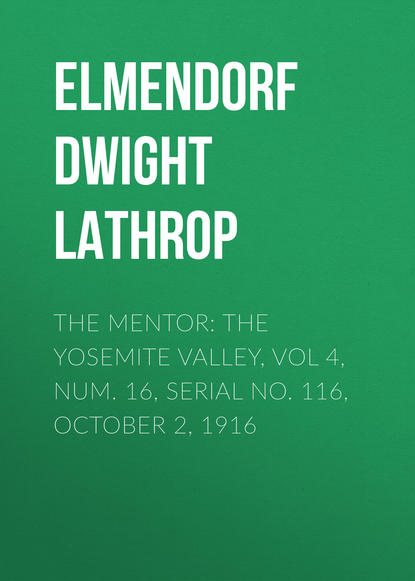По всем вопросам обращайтесь на: info@litportal.ru
(©) 2003-2024.
✖
The Mentor: The Yosemite Valley, Vol 4, Num. 16, Serial No. 116, October 2, 1916
Настройки чтения
Размер шрифта
Высота строк
Поля
The trail to Vernal and Nevada Falls leads past Happy Isles and is full of beauty and interest. It winds along the side of the rushing Merced River. The trail leads over a bridge commanding one of the best views of Vernal Falls, and shortly after passing Register Rock, it leads to Vernal Falls. Behind this fall rises the picturesque Cap of Liberty. This may be ascended by experts, but it is a difficult climb. The top of Vernal Falls may be reached by an easy path protected by an iron chain.
From Register Rock the trail, which now becomes narrower and steeper, makes a wide sweep to the right before reaching the top of Vernal Falls, where the flat rock permits an approach to the edge of the water. Just above is the beautiful Emerald Pool. The trail recrosses the river about half-way between the top of Vernal Falls and the bottom of Nevada Falls. Above the bridge is the Diamond Cascade, and below it is the Silver Apron, both beautiful waterfalls. From here may be obtained a fine view of the superb Nevada Falls. A steep and zig-zag trail leads to its top.
To reach Cloud’s Rest visitors follow the Vernal Falls Trail, diverging from it before reaching the bridge above the falls. The trip to Cloud’s Rest takes one day, and is a favorite among energetic tourists. From the Cloud’s Rest trail climbers can turn east and ascend the round summit of Half Dome. The extraordinary formation of this mountain attracts climbers, who are curious to see what the top of it is like. They find it to be just what they expect – a curved, smooth surface.
For anyone who has two or three days to spare for a single expedition, the trip to Merced Lake is a choice one. The lake is reached in one day by the trail that leads to Vernal and Nevada Falls. After the falls have been left behind the trail is a rough, wild path, disclosing scenes of great beauty on every hand. There is a comfortable lodge at the Lake, and in its waters are more fish than you can catch – yes, you and all your friends – in many a day.
Some of these trails lead on into the larger spaces of Yosemite National Park. The great majority of visitors confine themselves to the territory included in the Valley.
THE YOSEMITE VALLEY
The Camps
FIVE
The Valley is a camper’s paradise. Years ago travelers discovered its many advantages. The combination of deep shaded woods and open meadows, with a fine water supply close at hand, made its appeal to all lovers of nature, and long ago the Valley became a favorite resort for campers. Out of single parties, there soon developed an organized camping system in the Valley. As a result, there are now a number of little tent and bungalow communities, with populations varying from two or three hundred up to nearly two thousand. At one time, during 1915, the population of Camp Curry exceeded two thousand. To the lover of out-door life who wants to rest close to the earth, there is nothing more delightful than tent and bungalow life. The United States Government and the Park Service Company offer every convenience to campers, so that no one need bring material nor any supplies into the Valley. The camper may determine the conditions under which he will live. He may bring his own tent, if he cares to. Then, after securing a permit, he may pick out his own spot and raise his simple roof tree. Aside from the established camps there are spaces of land set apart and numbered, and these are for the use of those utterly care-free pilgrims who prefer to settle on a spot of their own choosing and lead the simple life. Upon arriving, the prospective camper can get a full equipment on reasonable terms. A list will be supplied to him, from which he can select every necessary thing for camp life – from a can-opener and tin pan to tents and tables. He can purchase these articles, or he can rent them by the week. If a vagrant life is desired, the camper may secure a pack-mule, pull up stakes from time to time, and move about as he chooses.
This is camp life in its most elementary aspect. From that the conditions of tent and bungalow life in the Valley range up to the finely equipped and organized camps, where the visitor may enjoy all the advantages and luxuries of comfortable hotel life, while at the same time living close to the ground. The established camps at present are Awahnee, El Capitan, Yosemite Camp, Lost Arrow and Camp Curry. The affairs of each camp are managed from its own central office, a building where mail is received and the interests of the campers are looked after. The daily life of these communities is full of incident. Each camp has its entertainments and its gala performances. One has a fine, large bathing pavilion and plunge; another, a festival hall. Moving pictures are exhibited in the evenings; there are lectures and concerts; and a large, well equipped dancing pavilion makes the hours fly fast for young people. Communication between the camps is easy, for there are auto-buses, “jitneys,” as well as ponies and burros, and things are stirring actively among the camps most of the time. No one need lack for entertainment. Between the single tent in a remote part of the Valley and the populous camp community there is a wide range for choice, and variety of conditions enough to make everyone happy.
THE YOSEMITE VALLEY
The Big Trees
SIX
A most interesting feature of the Yosemite region is the Big Trees. There are three groves of giant trees near the valley – the Tuolumne, Merced, and Mariposa. The first two named are small groves. The important grove is the Mariposa. This grove is so called from its situation in Mariposa (Butterfly) County. It occupies a tract of land about four square miles in area, and consists of two definite groups of trees. Its elevation above the sea level varies from 5,000 to 8,000 feet.
The Big Tree, or Sequoia gigantea, is found only on the west slope of the Sierra Range. The Redwood, or Sequoia sempervirens, its twin brother, is strictly a seaboard tree, being confined to the coast ranges. The Big Tree, however, is the giant of all, and it is of this species that the Mariposa Grove is made up.
The first grove of Big Trees discovered by white men was the Calaveras Grove of Big Trees in California. This was in the spring of 1852, and the discoverer was A. T. Dowd. Soon the story of the Big Trees found its way into the newspapers, and no other plant ever attracted so much attention or gained such celebrity within so short a period. The species was named in honor of Sequoyah, or Sequoia, to give it the Latin spelling, a Cherokee Indian of mixed blood, who was also known as George Guess. He invented an alphabet and written language for his tribe.
The Big Trees are the oldest living things in the world. It is impossible to appreciate their huge size from a mere description. They must be seen; and even then a sense of futility strikes the beholder. The Big Trees grow in groves, never forming groups by themselves, but always scattered among a much larger number of trees of other kinds.
Says John Muir, the famous naturalist: “The whole tree for the first century or two, or until it is a hundred or one hundred and fifty feet high, is arrowhead in form, and, compared with the solemn rigidity of age, seems as sensitive to the wind as a squirrel’s tail. As it grows older, the lower branches are gradually dropped and the upper ones thinned out, until comparatively few are left. The immensely strong, stately shafts are free of limbs for one hundred and fifty feet or so. The large limbs reach out with equal boldness in every direction, showing no weather side, and no other tree has foliage so densely massed, so finely molded in outline, and so perfectly subordinate to an ideal type. A particularly knotty, angular, ungovernable-looking branch, from five to seven or eight feet in diameter, and perhaps a thousand years old, may occasionally be seen pushing out from the trunk as if determined to break across the bounds of the regular curve, but like all the others it dissolves in bosses of branchlets and sprays as soon as the general outline is approached. Except in picturesque old age, after being struck by lightning or broken by thousands of snow-storms, the regularity of forms is one of their most distinguishing characteristics. Another is the simple beauty of the trunk, and its great thickness as compared with its height and the width of the branches, which makes them look more like finely modeled and sculptured architectural columns than the stems of trees, while the great limbs look like rafters, supporting the magnificent dome-head. But though so consummately beautiful, the Big Tree always seems unfamiliar, with peculiar physiognomy, awfully solemn and earnest; yet with all its strangeness it impresses us as being more at home than any of its neighbors, holding the best right to the ground as the oldest, strongest inhabitant.”
The Mariposa Grove – which was discovered in 1857 by Galen Clark – lies in a little valley occupying a depression on the back of a ridge. The Lower Grove contains 240 fine Big Trees. The Grizzly Giant is the largest of all. It has a circumference of ninety-three feet and a diameter of thirty and six-tenths feet. Its main limb is six and one-half feet in diameter. This tree is very much injured, and its size has been decreased by burning. It has long since passed its prime, and has a battered and worn appearance.
In ascending to the Upper Grove the road goes through a tunnel cut through the heart of the “Wawona,” a living Sequoia. This tunnel is ten feet high and nine and one-half feet wide at the bottom.
The Upper Grove contains 360 Big Trees, averaging in age about 2,500 years. About ten of the trees exceed 250 feet in height. Three of these have a circumference of over ninety feet.
The bark of the largest trees is from one to two feet thick. Toward the end of winter the trees bloom, while the snow is still eight or ten feet deep. The flowers are pale green and pale yellow. The seeds are small and light. The cones remain on the tree for many years.
The Big Trees might live forever. There is no absolute limit to their existence. Death is due only to an accident. The leaves alone die of old age, and these are renewed.
THE YOSEMITE VALLEY
By DWIGHT L. ELMENDORF
Lecturer and Traveler
MENTOR COLOR PLATES
CATHEDRAL SPIRES
YOSEMITE FALLS
EL CAPITAN
HALF DOME
THREE BROTHERS
VIEW FROM GLACIER POINT TRAIL
Entered as second-class matter March 10, 1913, at the postoffice at New York, N. Y., under the act of March 3, 1879. Copyright, 1916, by The Mentor Association, Inc
Rest here for a time by the side of the Merced River while I tell you something of this peaceful, lovely valley. Look over to that further cliff and watch the silver stream of the Yosemite descend in three gleaming white steps from the summit of rock 2,600 feet above us to the meadow level where we stand. In its first flight of 1,430 feet it falls a third of that distance in a snowy column, then turns to wreathing smoke, through which many glistening darts shoot down to the rocky basin below. Here the misty elements are resolved again into water, and the stream tumbles frothing through rocks to its second flight, then on to the lower fall of 320 feet, when it dashes on a bed of boulders and hurries to join the Merced River.
It is an ever present sight in the heart of the Valley, and our eyes turn to it frequently during the hours of daylight. And, all through the night, we hear the hushing sound of its falling waters as it whispers to us of the many beautiful things that Nature has given us in this valley of enchantment.
So you see Yosemite in midsummer. Then its fall is almost as fairy-like as that of Bridal Veil. But in April and May, when it pours down the accumulation of the winter snows, it is a foaming torrent, and its tone is deep and strong.
The Yosemite has been gradually disclosing its features to us since early morning. The first impression that we experience as we leave the town of Merced is one of steady ascent into a narrow gorge, through which a busy, turbulent stream – the Merced River – pursues its course. The train labors sturdily up until it reaches El Portal, where there is a pause at the hotel for lunch. Then the trip is resumed in auto buses that take us on up through a valley, winding and narrowing into a notch that seems at times as if it would end in sheer walls of rock. But, in the course of an hour or more the way broadens, and we find wider stretches, wooded with tall pines and stately sequoias.
Then we catch a glimpse of Elephant Rock, of Cathedral Spires, of the delicate lacery of Bridal Veil Falls, and, opposite, the massive bulk of El Capitan. Soon the slender, swanlike neck of Yosemite Falls appears, and we roll through Camp Awahnee and out into the wide, level vale where Yosemite Village rests. Here we draw a long breath, and a sense of peace and contentment takes possession of us – a feeling of complete isolation from the world of care and trouble. There is something so intimate and friendly – so “homey” – about the wide, green meadow that stretches before us from the banks of the fast flowing Merced to the wood at the foot of Yosemite Falls. Around this level mead the camps cluster; Yosemite, El Capitan, and Lost Arrow camps close to the base of the falls, quiet Camp Awahnee by the roadside across the river, and busy Camp Curry a mile east of the village and just below Glacier Point.
Yosemite National Park
We are now in the very center of Yosemite Valley – though not of Yosemite National Park. Do not mistake the part for the whole. The Yosemite National Park – created a park October 1, 1890 – is a huge tract of land, 1,124 square miles in area. It contains many valleys, mountains, streams, lakes, and waterfalls. Its vast territory has been explored by countless travelers, and it is the favorite playground of the Sierra Club – a body of hardy and adventurous men and women trampers, campers, and mountain climbers.
The particular gem of the Yosemite National Park is our dearly treasured Yosemite Valley, seven miles in length – and that is what we have come to visit. When we arrive there we reach a high elevation. The floor of the Valley is 4,000 feet above sea level, and on all sides the mountains rise to heights varying from 3,000 to 6,000 feet more. The highest point in the Valley is the summit of Cloud’s Rest, which is nearly 10,000 feet above sea level.
And, now that we are here, you ask: “What is this valley, and how did it come to be?” There are several geological explanations of it, varying in character. Prof. J. D. Whitney, the first scientist to study the Sierra, thought that the Yosemite was “the result of the sinking of a local block of the earth’s crust having the exact outlines of the Valley,” and he denied that glacial action had anything to do with it. But the generally accepted explanation is that the Valley was once a tortuous river canyon cut by the Merced River, and that the cutting work of this stream was done so fast that the “tributary valleys soon remained hanging high on either side.” Then the canyon became the bed of great glaciers which, in moving, “scooped” the Valley into its present form. This, of course, was a matter of hundreds of thousands of years.
Accepting that explanation as correct, many of the natural conditions that we find in the Valley are easy to understand – such as the smooth polished surfaces of El Capitan and Half Dome.
And now you ask: “What is there to do and see?” It is a valley of varied diversions. There are many things to do and many beautiful spots to visit, and you may choose according to your tastes and your physical ability. Are you a sturdy tramper? You may take your pack and staff and assail the mountain citadels that challenge you on every side. Do you love the saddle? You can find bridle paths that will lead you through the cool, dense woods, by lakesides, to the foot of waterfalls, and up to the summits. Are you unequal to the exertion of tramping or riding? The joys of the Yosemite are yours none the less, for high powered auto cars will carry you in comfort to the points of greatest interest in the Valley, out to the groves of giant trees, and even up to the supreme commanding spot of all – Glacier Point.
You may take in the Yosemite as a visiting tourist, in which five or six days may suffice you for sightseeing, or you may settle down as a camper or hotel guest, in which case days and weeks slip by, and you soon lose all sense of time in the sweet repose of the Valley. For the greater number a touring visit is all that is possible. You tell me that you are here for a few days. How may you best occupy them? It is not necessary for me to answer your question in detail, for the affairs of the Valley have been systematized in a most businesslike fashion, and all such information is ready to hand. You can obtain schedules of trips for two, three, four, and on up to nine and ten days. The United States Government has done and is doing a good work in developing this great natural recreation park, and all the Government asks of us is that we will take advantage of it. The attitude of Uncle Sam is expressed in the legends posted on trees throughout the Valley, all of which mean in substance: “This beautiful park is yours. Help us to preserve it and make it attractive.”
Evening in the Valley
We have come up from Merced in the morning, and we have arrived in the Valley at three o’clock. Let us make the most of the remainder of this fair summer afternoon. We walk out across the green meadow for a closer view of Yosemite Falls. The shadows of El Capitan and the Three Brothers are already creeping over the valley, and the air has a touch of evening cool as we enter the woods. The walk is longer than we thought. The tall, sheer cliffs make the falls seem nearer than they are. At length, after pursuing the path for some distance through the woods, we come upon an open spot from which we can gaze up and drink in the beauty of the three white leaps of water. This is the favorite spot – the choice viewpoint of artists and photographers. A short climb brings us to the foot of the lower falls, and there we rest and watch the seething basin while the soft mist plays upon our faces. The woods about us are in deep shadow and odorous of pine. Above us goes the trail that leads up through a narrow gorge to a point at the summit of the falls. We are seated in the very sanctuary of the Yosemite. It is an hour to remember.
On returning, we pause a moment by the roadside on the meadow at the concrete bench placed there in memory of Galen Clark, a lover and student of the Yosemite, and discoverer of the giant trees of the Mariposa Grove. Galen Clark apparently drew vitality from his aged tree friends, for he lived to be 96 years old. He is buried in the Valley, and the concrete bench is placed on the spot where he frequently sat to gaze on the falls. Though it is now evening and the sun has disappeared, the Valley is suffused with soft reflected light from the huge flat, mirror-like face of Half Dome. In the course of an hour the golden glow on that great oval surface of rock far above us turns to shimmering silver, and then to a ghostly gray that finally gives way to night.
Mirror Lake and Happy Isles











